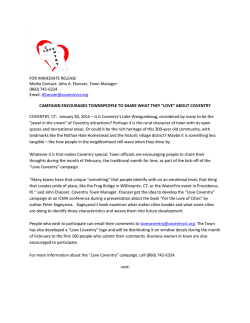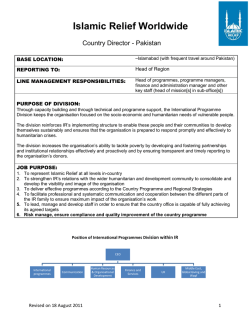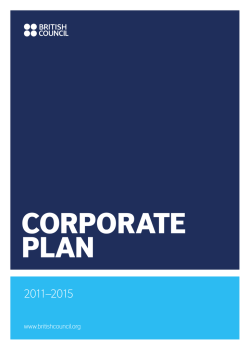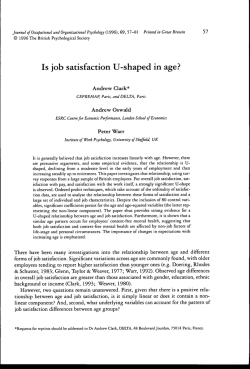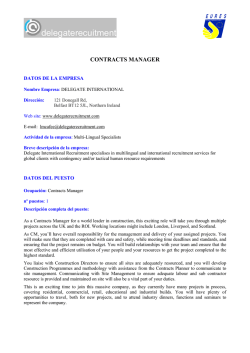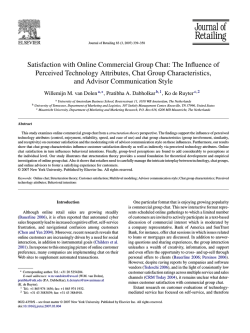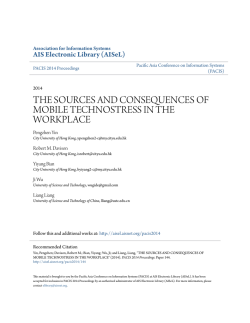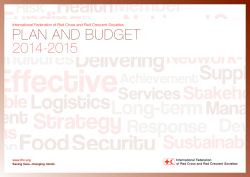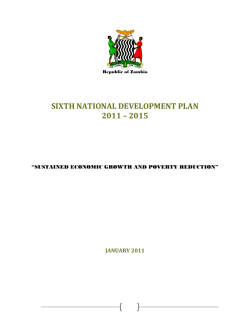
Corporate Plan 2010–2015
corporate plan 2010-2015 I MISSION STATEMENT Mission Statement for 2010-2015: “We aspire to be a dynamic, global, enterprising university. We will work in partnership with external organisations through our research and engage our students as partners in a community of learning.” 2 II Statement of Core Values Core Values for 2010-2015: 1. We are committed to the principle of academic freedom, founded on rational enquiry conducted with integrity. 2. We value lifelong relationships with our students, from their first engagement with the University, throughout their studies, and their future lives as alumni. 3. We contribute to economic prosperity and to social well-being. Through our research and teaching we contribute to solving some of the most important problems or ‘grand challenges’ in our society. 4. We seek to foster excellence, innovation, creativity and enterprise among our students, staff, and partner organisations. 5. We aim to work in sustained partnership with external organisations and we encourage collaboration across internal boundaries. 6. As an organisation we promote supportive teamwork, and we value diversity, fairness and equality of opportunity. 7. We value our staff and expect them to use their professional judgement. We therefore seek to develop their knowledge, skills and capabilities for their own professional fulfilment and the University’s benefit. 8. We take a proactive approach towards caring for the environment, including carbon reduction, and we seek to adopt best practices in the interactions we have with our local communities. 9. We aim to have cost effective procedures and processes and we seek continuing improvement in what we do. 3 III Teaching and Learning 2010-2015 There are three priorities in the Teaching and Learning section of the 2010-2015 Corporate Plan to reflect major changes in our external environment. These are: student satisfaction (as measured by the National Student Satisfaction Survey and our own biennial survey); completion rates (as defined and measured by HEFCE); and the achievement of a Positive Destination, including graduate-level jobs, by our graduates (as measured by the Destination of Leavers from Higher Education (DLHE) survey). 1. Student Satisfaction Aims: 1. We aim to improve students’ satisfaction by empowering them as participants in a community of learning where staff and students work together to learn, create, solve problems and research. That community also includes external practising professionals, employers, and alumni. 2. Teaching is designed to inspire and engage students in their chosen course through a range of techniques which encourage lively, interactive learning, and by drawing on relevant research and professional practice. Excellence in classroom teaching will be enriched by appropriate use of virtual environments, technology and specialist facilities. We will measure how effective our teaching is by: using feedback questionnaires at the mid-point of modules; by the evidence from course reviews; and by the results of our biennial student satisfaction survey where we will seek to achieve straight A Grades for the quality of teaching on all courses in 2012 and 2014. Targets for improvement, where appropriate, will be agreed at individual, course team, and Departmental levels. 4 2. Student Success and Completion Aims: We aim to improve the learning environment to maximise student achievement and completion. This requires that: 1. Course and module information, timetables, assessment tasks & deadlines, and course administration are simple to understand and student-focused. 2. The academic infrastructure which supports excellence in classroom teaching and learning works well and is effective from a student perspective. 3. Communication systems to and from students work well. 4. Academic and pastoral support systems are well designed and appropriate. 5. Staff: student ratios and direct contact time are appropriate. 6. Assessment is proportionate and well designed, is returned to students within the agreed timescale, and contains feedback that identifies both strengths and weaknesses of the student’s work. 7.Rapid feedback systems from students are used to understand and respond to their concerns about the quality of teaching, course administration, and/or academic support. We will measure how effective our information, communications and support mechanisms are by: using questionnaires and other feedback methods; and the results of our biennial student satisfaction survey where we will seek to achieve A Grades on these elements of the learning experience in all courses by 2014. Targets for improvement, where appropriate, will be agreed at individual, course team, and Departmental levels. We aim to provide the appropriate physical infrastructure and facilities that will engender a sense of community, including the new Students’ Building due to open in 2011, and the Engineering & Computing Building, due to open in 2012. 5 3. Graduate-level Jobs, Careers and Further Study Aims: We aim to assist students in achieving their further study, career or self-employment aspirations. To this end, our curriculum will be employment-related, making use of research activities, real or ‘live’ projects (sourced from employers or professional practice), placements and work experience as appropriate. This means that: 1. All courses will provide learning experiences that prepare graduates to proceed to Masters or Doctoral study as appropriate, or to postgraduate professional training. 2. All courses are designed to develop and assess the generic graduate capabilities and skills that employers are seeking, including enterprise and entrepreneurship, an international outlook and understanding of global issues, communication skills, team working and IT fluency. The Add+vantage Scheme has a major role to play here for undergraduate students. 3. All UK undergraduate students have at least one international experience through a course project, or through an Add+vantage module, or through visits, placements and exchanges during their period of study. 4. All postgraduate students have the opportunity to take our Global Leaders Programme. 5. Where appropriate, courses are designed in conjunction with, and accredited by, employers or professional bodies to develop the specialist knowledge and advanced skills required for (post)graduate level employment in that field. This includes the development of multi-disciplinary courses that address emerging or changing sector needs. 6. Personal Tutors and Course teams take responsibility for the career destinations of their final year students, supported by the central Careers Service and Faculty/School employment units. We will measure how effective we have been in enabling our students to obtain places for further study/training, or graduate-level employment, by using the annual DLHE survey results. The target will be to achieve 80% of graduates achieving graduate level jobs or progression to postgraduate study by 2015. Targets for improvement, where needed, will be agreed at course team and Department levels. 6 Summary In summary, and taking all three sets of aims into consideration, our courses will be designed so that students: 1.Reach high academic, professional, vocational or creative practice standards. 2. Are challenged to think for themselves, assess evidence, test assumptions, frame and solve problems. 3. Are introduced to the latest research in their subject and its methodologies, and acquire research skills themselves – all at an appropriate level. 4.Gain from the global community of which Coventry University is a part, and have the opportunity to engage with international issues and comparative perspectives through their study and learning experiences. 5.Develop a sense of professional responsibility and social citizenship including an ability to engage with ethical issues in a well-informed manner. 6. Become enterprising and entrepreneurial graduates, contributing to innovation, creativity and productivity in the organisation or community of practice which they join. 7.Develop the leadership capabilities, communication competencies, and generic skills that employers of graduates are looking for. 8. Obtain rewarding and interesting careers. Summary Metrics to be used to assess our progress against our Teaching and Learning Aims: • Students rate their overall satisfaction with the quality of their course in the 2014/15 National Student Survey (NSS) and the 2015 internal biennial survey above 85% with no individual element or subject being rated below 70%. • The qualification completion rate for the University is 95% in the 2014/15 Higher Education Statistical Agency return. • By 2015, 80% of our undergraduates will take up the opportunity of a period of work experience, internship or placement related to their course or their future career intentions, and all will have an international experience through their programme of study. • Positive Destination to be at least 80% by 2015 as measured by the DHLE survey. • The staff to student ratio (SSR) to be in the top quartile for a post ‘92 university throughout the period as measured in the Times League Table. 7 IV Applied Research 2010-2015 The Research that we undertake is primarily: • Applied in nature and based on excellence in discipline-based research, pedagogical research, or knowledge transfer including CPD activity. • Intended to deliver beneficial impact to the economy or society in the short to medium term. In addition, in each of our Schools and Faculties there will be at least one major project focused on a longer term ‘grand challenge’ that society faces today such as low carbon solutions, an ageing population, sustainable environments, human security, or social inequalities. • Conducted with, or for, an external organisation or a consortium of public or private sector partners. • Focused on problems which require multidisciplinary perspectives and often a team-based approach. Our Applied Research encompasses: • Individual, Group and Institute research programmes. • National and international funded projects. • User-led R&D. • All forms of knowledge exploitation including patents, licensing deals, company spin-outs, joint ventures. • Consultancies and the provision of authoritative and independent advice. • Provision of specialist facilities and related services to external organisations. • Bespoke courses/CPD for individuals and for corporate clients for the purpose of knowledge transfer and advanced skills development. Coventry University’s Health Design & Technology Institute 8 Aims for Applied Research 2010-2015: 1. To undertake public and privately funded applied research regionally, nationally and internationally to generate new knowledge, and to apply and disseminate it effectively. Our Applied Research will have contemporary relevance and will contribute to economic wealth and social well being. 2. To deliver excellent research, recognised as such within the Research Excellence Framework (REF), which establishes and maintains our academic authority. Each Unit of Assessment submitted to have 60% of outputs judged as ‘world leading’ or ‘internationally excellent’ in the next REF. 3. To increase staff capability and capacity in Applied Research further, including nurturing cross-disciplinary teams. 4. To address selected “Grand Challenges” through the development of partnerships with organisations in the voluntary, public and private sectors. 5. To align and integrate the work of the CUE project divisions, Applied Research Institutes and Applied Research groupings in Faculties and Schools. To enable this, our current Institutes will be aligned to the “Grand Challenges” and will provide a point of focus for the development of multi-disciplinary communities of researchers in each of these fields. 6. To expand and further enhance the Technology Park. This will bring together physically those researchers addressing the “Grand Challenges”, and provide the shared facilities required to stimulate the development of the wider multi-disciplinary research community. We will engage key stakeholders, including the City Council and regional bodies, as well as Private Sector partners, in addressing areas of shared interest such as the low carbon agenda. 7. To explore web-based collaborative tools and applications, to understand the likely future scale of co-production and co-creation of knowledge, and the way we visualise results. We are interested in developing, with others, innovative models of research communities particularly in the social sciences, humanities and arts, and in “Open Access” channels to our findings. 8. To ensure our Applied Research appropriately enriches the teaching and professional development that our students receive, and underpins the CPD and employer-based training that we offer. Metrics to assess progress on our Applied Research agenda 2010-2015: • £48 million applied research income by 2013 rising to £60M by 2015 (Coventry University Group figure). • To be in the top 10 of the post 1992 universities in the next REF. • 90% of academic staff to be applied research active by 2012. • Academic staff spend 20% of time on AR by 2012 and 30%-40% by 2015. • By 2015 25% of applied research income to be private-sector led, including CPD income. Applied Research Income 70 60 £M 50 40 30 20 10 2009/10 2010/11 2011/12 2012/13 2013/14 2014/15 9 V The Global University By aspiring to be a ‘global’ university we mean that: 10 • We conduct research that is judged to be world-leading or internationally excellent through the peer review process and the REF. • We conduct research into global problems drawing on international sources of funding e.g. the EU. • We have active partnerships with universities and colleges in all continents through which we pursue joint research and teaching programmes, student and staff mobility, dual and double degrees and pathway programmes. We seek out external funding opportunities to further this agenda. • We work with global companies on joint research and development agendas. • We use our global connections to benefit our local communities, city and region. • All of our students have the opportunity to acquire a new language or deepen competence in an existing second language alongside increased cultural proficiency and knowledge of global issues. • We offer our UK students a range of mobility opportunities to study, do a project, or gain work experience abroad so that they are better equipped to be global leaders and employees of the future. Similarly, we offer our international students the opportunity to have work experience in the UK. • Our courses draw on material and case studies sourced globally and encourage the examination of issues from different cultural, economic and socio-political perspectives. • We recruit students from all over the world and encourage the formation of social and professional networks across national boundaries which continue among our alumni. • We exploit digital communication and collaborative technologies to bring students and staff together across different countries to participate in shared seminars, undertake joint research projects and learn together through taught modules. • We disseminate our knowledge and expertise globally using digital and virtual means as well as the traditional forms of academic publication, knowledge exchange and transfer. Aims: 1. To develop more multi-touch, deep, international partnerships where our joint activity includes a wide range of shared activities. We will do this by setting up an Academic Partnership Unit. This unit will support the development of new and existing collaborative relationships, coordinate the development and delivery of programmes and oversee quality management. 2. To increase international student numbers at Coventry, and to develop the London Campus as planned. 3. To ensure that every course contains a substantive international element that requires students: to acquire a comparative perspective; or to engage with globally important issues; or to conduct joint projects with peers in another university overseas mediated via digital technology. 4. To increase opportunities for UK students to undertake an international fieldtrip or study visit, and/or a study or work placement abroad. Similarly to find and offer work experience opportunities in the UK to our international students. 5. To give greater priority in supporting Applied Research to projects with international/global companies or with overseas partners including HEIs, governments and NGOs. 6. To enhance the IT infrastructure to enable the many tools for academic collaboration so that it is easy and reliable to share and discuss research data, to run trans-national seminars, to set up student-to-student projects etc. Metrics to assess progress in becoming a ‘global’ university by 2015: • Income from course delivery overseas at £7.5 million p.a. by 2015. • By 2015 all UK students to have an international experience of some kind in their programme of study – either through joint projects with students in other countries mediated by ICT, or through study visits, work placements etc. • By 2015, all overseas students to be offered work-related experience of some form in the UK – through internships, placements or work-related projects. • By 2015 all courses to evidence a substantive and definable international component – for example, an international literature review, overseas case studies and/or analysis of global issues and perspectives. •Global Leaders Programme taken by a minimum of 15% of postgraduate students by 2012 rising to at least 33% by 2015. • 3127 international students on the Coventry Campus by 2012/13, rising further to 3576 by 2015/16. 1674 international students on the London campus by 2015. • I-graduate Survey to show steady improvement in international student satisfaction year-on-year on key questions. International CU Students studying in the UK 6000 5000 4000 Total 3000 Coventry London 2000 1000 0 2010/11 2011/12 2012/13 2013/14 2014/15 2015/16 11 VI Being a Sustainable University Our approach to being a sustainable university covers six areas: • Securing financial sustainability. • Investment in the development of our staff. • Continuous improvement of our processes. • Environmental sustainability. • Building lifetime relationships with our Alumni. • Management of strategic investment programmes. For each of these we have agreed strategic Aims and Metrics which are set out below. 1. Securing Financial Sustainability Aims: 12 1. To achieve income growth and surplus in line with the Financial Plan for the period as set out below, understanding that the external economic and political environment may require changes to this Financial Plan during 2010-2015. 2. To increase the diversity of income generating sources in both teaching and applied research. 3. To ensure that we achieve a financially sound balance across our portfolio of courses and that we generate a sufficient surplus to allow for re-investment in, and improvement of, our students’ academic experience. 4. To manage the performance of the Group Subsidiaries (CUE, ACUA, London Campus) to meet or exceed targets, including surplus generation, as stated within their business plans. 5. To ensure planned levels of Return on Investment are achieved for all major development projects and programmes. 6. To invest in staffing and physical infrastructure sufficiently to deliver the aims of the Corporate Plan. 7. To maintain effective relations with all funders and the confidence of our financial stakeholders. 8. To undertake robust management of critical operating risks. Metrics to assess progress against Aims: • Income growth to have reached £243m by the end of 2014/2015 and annual surpluses to be 3% or as agreed with funders. • Achieve student number targets each year as set out in the Table below. • Applied Research to account for 20% of income by 2014/2015. • Income from non-HEFCE sources to increase by 10% over the period of the Plan. • Financial performance of all undergraduate and postgraduate programmes to achieve surplus or at least break-even respectively by 2012/13. • Subsidiary Companies (ACUA, CUE and CULC) to achieve expected targets and surpluses throughout the Plan period. •Return on Investment achieved as expected for major investments in staffing, assets (e.g. new buildings) or new activities/programmes. • Sufficient liquidity to meet cash needs as they arise for operations and investment opportunities. Income Generation (Group) 260 250 240 £M 230 220 210 200 190 2010/11 2011/12 2012/13 2013/14 2014/15 2015/16 Total Planned Student Numbers, FTE’s 2010/11 2011/12 2012/13 2013/14 Undergraduate 11,915 12,210 12,398 12,256 Postgraduate 960 1,025 1,052 1,070 International Coventry University 2,888 3,057 3,127 3,180 International Coventry University London Campus 390 730 1,067 1,356 Employer Engagement Programme 2,155 3,155 3,155 3,155 Total 18,308 20,177 20,799 21,017 13 2. Investment in the Development of our Staff Aims: 1. To improve the quality of teaching and learning, the level of student satisfaction with their academic experience, and increase the amount of Applied Research that we do successfully. 2. To set up a staff development programme that helps staff to respond to the challenges and opportunities of working as a Global University. 3. To deliver the aims of our Single Equality Scheme including the objectives which promote progression and success for a diverse staff and student body. 4. To enable staff to embrace and optimise the potential of advances in technology. 5. To develop the knowledge and skills of our staff so that they feel confident working in multi-disciplinary or multi-professional teams, and can develop rewarding external partnerships. 6. To provide leadership development and management training that aligns the delivery of University strategy with the release of talent and potential of individuals and teams. Metrics to assess progress in achieving our Aims: • Student satisfaction with the quality of teaching and course management rises as set out under the Teaching and Learning metrics. Student satisfaction with other aspects of their experience at Coventry is maintained at the high levels achieved in 2009 internal student satisfaction survey. • 90% of academic staff and 33% of senior Professional Services staff are actively and successfully engaged in Applied Research. • By 2015, 66% of academic staff to have experience, through their teaching or applied research, of successful engagement with at least one overseas partner. • Steady increase in staff performance levels, capabilities and skills as measured through the DPR indices. • Overall level of staff satisfaction as measured in our biennial staff survey to rise to 86% by the 2016 survey. Staff Satisfaction 87% 86% 85% 84% 83% 82% 14 2010 2012 2014 2016 3. Environment Aims: 1. To be a leading university in our environmental and carbon reduction performance. 2. To ensure environmental issues, energy conservation and carbon reduction are a driving force in the University’s Estates strategy and are supported by staff and student engagement. 3. To develop a coherent campus-wide space strategy to inform resource usage. 4. To work in partnership with relevant organisations to act and impact on global environmental issues. 5. To achieve improvements in staff and student satisfaction with the University’s environmental performance. Metrics to measure progress in achieving these Aims: • To be in the ‘first class’ division of the People and Planet Green League by 2015. • To achieve 35% reduction to 9,500 tonnes in carbon footprint by 2015. • To have achieved 80% recycling/reuse rate by 2015. • BREEAM ratings of ‘Excellent’ achieved for university-owned, new buildings. • To achieve 10% improvement in space utilisation from 8.7 m2 to 7.8m2 per FTE by 2015. • Staff and student satisfaction ratings with our environment strategy at 85% (Grade A ratings) by 2014 and 2015 respectively, as measured in internal, biennial satisfaction surveys. Carbon Reduction 14 Tons (000’s) 13 12 11 10 9 2009/10 2010/11 2011/12 2012/13 2013/14 2014/15 15 4. Continuous Improvement of our Processes Aims: 1. To design and maintain effective key functions and processes that add value, are cost effective, timely and are fit for purpose. This will include, where appropriate, standardisation and simplification of our current systems and processes. 2. To establish a set of benchmarks for key processes and improve performance against them through regular reviews. 3. To establish and embed continuous improvement in processes at University, Faculty/School and Service levels. 4. To enhance our processes for capturing and implementing improvement ideas from staff. 5. To improve procurement and contract management to effect savings and improve the quality of service delivered. Metrics to measure progress in achieving these Aims: • To be in the Upper Quartile versus benchmark external organisations in 5 core processes throughout the Plan period: HR, Finance, Registry, IT, Estates. • 5% year on year reduction in number of formal complaints made about processes from students, business customers, and staff. •Good practice case studies evidencing successful implementation of staff suggestions disseminated across campus each year. •Reduction in procurement as a % of total costs, from 34% to 31% by 2015. • 16 Staff satisfaction ratings with processes increase in each biennial satisfaction survey through the Plan period. 5. Building lifetime relationships with our Alumni Aims: 1. To strengthen the existing networks/communities/friendships associated with Coventry University. 2. To offer services and support to our alumni to maintain their continued relationships and involvement with us. 3. To inspire alumni to maintain contact and develop their engagement with the University. 4. To identify relevant opportunities for our alumni to become actively involved in ways that benefit the University or its wider community. Overall Engagement Alumni Numbers % of Alumni rated “Engaged” as measured through Raiser’s Edge 75000 7% 70000 6% 65000 5% 60000 4% 55000 3% 50000 2% 45000 1% 40000 2010/11 2011/12 2012/13 2013/14 2014/15 0% 2009/10 2010/11 2011/12 2012/13 2013/14 2014/15 6. Strategic investment Projects or Programmes (defined as being £500k+) Measured on whether they achieved the time, cost, and quality standards as defined in their Project Plans, and the Return on Investment as set out in their Business Cases. For the period 2010-2015 this includes the Coventry University London Base, the new Students’ Building, and the new Engineering and Computing Building. Metrics to assess progress in achieving these Aims: • Increase in number of actively engaged alumni (both in actual numbers and as a % of the database), with engagement measured through a scoring system (KARMA). • Number of alumni with live contacts on our database increases to 70,000 by 2015. • Faculties to be working with 500 alumni supporters each by 2015, across advisory groups and committees, offers of work placements, live projects, employment opportunities, direct input into courses, and mentoring students. • 1,500 alumni to be donating to the Annual Fund (Phoenix Foundation) by 2015. • Philanthropic giving to meet annual targets set. 17 VII Key Performance Indicators: the 2015 Test 1. Our position in the sector as set out in the Times League Table Our KPI here is to be in the 60s range by summer 2012 and in the top five post-1992 English universities by the summer of 2016. This will be achieved by: • National Student Survey satisfaction rating to be 80% by 2012 (with no individual component below 70%), rising to 85% by 2015. • Positive Destination to be at 80% by 2015 as measured by the DLHE survey. • Completion rate (as defined by HEFCE) for the University to be no worse than 95% by the end of 2012 and sustained at that level through the rest of the Plan period. 2. Financial Sustainability of the University The KPIs here are: •Yearly operating surplus to be 3% or as agreed with our funders if higher. •Reduction in procurement as % of total costs from 34% to 31% by 2015. • Current ratio of Assets to Liabilities throughout the period to be not less than 1.5 to 1. • 35% carbon reduction achieved by July 2015. 3. Income growth and diversification The KPIs here are: • Income growth to £243m by end 2014/15 and in line with the Financial Plan throughout the period. • Income from Applied Research in the Coventry University Group to rise to £48 million by 2013 and to £60M by 2015. 4. Being a ‘global’ university The KPIs here are: • International student numbers at 5,250 by 2015, including the London Campus. • By the start of the academic year 2015/16 every UK undergraduate student will be guaranteed at least one international experience as part of their programme of study, and 33% of postgraduates will be taking the Global Leaders Programme alongside their Masters or Doctoral course. • Income from course delivery overseas to be £7.5m p.a. by 2015. 5. Staff development, achievements and satisfaction Measured by: •Groups submitted to the REF have 60% of their output graded as ‘internationally excellent’ or ‘world class’. 18 • 90% of academic staff to be contributing to the Applied Research income generation targets by 2012. • Improved student satisfaction with quality of teaching, assessment and course organisation measured through the NSS. • Staff satisfaction level as measured by our biennial Staff Satisfaction Survey to be 86% by 2016 survey. Coventry University London Campus 19 Stakeholder Analysis 20 Success as measured against KPIs Key Stakeholders Needs/Wants Source Initiatives/Actions Students Parents Alumni • A valued degree – leading to further study or graduate level employment. • A good, caring, safe student experience, with quality accommodation and facilities. High standards of teaching and academic support. • A University to be proud of, so that we retain involvement. • Student Surveys: • Focus groups. • Consultative Committees. • Recruitment/ Development Office contacts. • Alumni. • Add+vantage programme and increased work experience/ placements/ internships. • New Student Building. • Focus on student satisfaction, completion and employment. • Student numbers. • Completion %. • League tables position. • Student satisfaction %. • Positive Destination %. • Alumni numbers and % involvement. • £ fund-raised. Employers Businesses • Employable students with right skills and capabilities. • Partnership working. • CPD. • Research with beneficial, measurable impact on their organisation. • Focus groups. • Business Development Manager reports. • Board of Governors. • National reports. • Pedagogic developments, eg Activity Led Learning. • Add+Vantage programme. • Global Leaders Programme. • Increased Applied Research (AR). • ACUA. • Increased CPD. • Growth in AR/CPD income. • Graduate-level employment %. • Work experience targets met. • Employer Engagement FTE numbers met. Schools Colleges • Good quality relevant courses/degrees. • Successful students. • Close links and partnership. • Focus groups. • Recruitment contacts through RAO. • Phoenix Partnership programme. • Student numbers. • Completion %. • League tables ranking. • Positive Destination %. • Student satisfaction %. HE Funders (eg HEFCE, NHS) • Meeting the public agenda with new thinking coupled with solutions and skills. • A cost-effective University that is flexing to meet government priorities. • Regular meetings, conferences etc. • White Papers. • Consultation/policy documents. • New or revised courses that meet skills and knowledge priorities in line with national policies. • Institutes. • Employer Engagement Programme. • New Engineering building. • Turnover/income growth %. • Investment %. • Number of policyrelated pilot programmes. Applied Research funders • As for HE funders but emphasis on innovation, new thinking and solutions. • Close relationships with users of research. • CUE. • BDMs. • Principal Investigators. • RCUK. • TSB. • Applied research policy. • New Institutes and ARGs. • HEIF4 plans. • Corporate Partnership Unit. • Turnover/income growth %. • Growth in AR income. • Profile on partnership development ‘staircase’. Success as measured against KPIs Key Stakeholders Needs/Wants Source Initiatives/Actions Professional Bodies/Agencies • A progressive University, effectively run, with high standards of outcome alongside practicefocused innovation in the curriculum. • Regular meetings and conferences. • Reports/Policy papers. • PSB visits. • As for HE funders with demonstration of dissemination of innovative practice. • Externally funded projects focused on practice development. • QAA and PSB accreditation reports. • Coverage of innovations in academic and professional press. • Representation on PSB senior bodies. • Income from projects. HE Partners, home and abroad • A respected University adding value and meeting expectations on developing joint activity. • Partners direct. • International student satisfaction survey. • British Council, UKTI. • International strategy. • New bilateral agreements. • AR or pedagogic networks and associations. • UKIERI and PMI2 engagement. • Number of ‘live’ multitouch agreements. • Student progression from partners. • Staff and student exchanges. • Number of joint AR and curriculum projects. Staff • Solutions to issues identified through surveys and other means. • A successful, financially sound and wellmanaged University with good, long-term prospects. • Successful career development. • Staff Satisfaction Survey. • Focus groups. • Biennial satisfaction surveys. • Pay and Reward Scheme and DPR appraisal system. • Leadership development programme. • Estates Strategy and related investment. • Staff satisfaction %. • Staff retention levels. • Staff promotion within and to posts outside the University. • Estates strategy implementation milestones. Suppliers of goods and services • Clear briefs and efficient, IT-enabled processes. • Opportunity to develop deeper/broader relationships with the University. • Supplier interface. • SMART processes and procedures. • Procurement policies. • Procurement savings. • Number of strategic partnerships. City and its communities • A successful flourishing university, raising the profile of the city, bringing business/ employment to the city, and its economy. • City Council contacts and Coventry City Partnership. • Joint profile-raising. • Support for City initiatives. • Masterplans. • Investment in Estates development and land acquisition. • Joint applied research programmes. • Joint engagement in cultural events and programmes. • £ Estates investment. • Student numbers. • New jobs created. • New businesses started/attracted, and SMEs assisted. • Funding secured for joint initiatives and research projects/ programmes. 21 External Environment: PEST Analysis Political Economic 22 Planned actions and initiatives Factor Impact on University • Government continues ban on growth in UK full-time undergraduate numbers as student support costs become too high. • No opportunity to bid for ASNs. • ELQ rules remain. • No fee increases in medium term. • Secure EEP ASNs and drive further growth in this direction. • Switch marketing and recruitment effort to PG and international students. • More income needed from AR activities. • Drive to improve skills and workbased training remains but is subdued in recession in private sector and cuts in public sector. • Demand for employer-based, offsite delivery less certain. • Opportunities for increased CPD activity may be harder to convert. • ACUA and faculties/schools prioritising CPD. • HEIF4 priority to improve CPD offering. • New Government is more interventionist. • Reduced focus on widening participation; FE favoured for vocational HE delivery. • STEM subjects prioritised to detriment of others. • Regulation increases. • Reduced numbers of FT undergraduates if quality judged poor. • Raise entry grades and less reliance on Clearing. • Experiment with new modes of delivery. • Focus on new criteria for “quality”. • Trans-national HE growing in importance; new private providers of HE establishing in UK and globally. • Increased competition for international students. • Need to establish better partnerships for overseas delivery. • Opportunity for joint ventures with new private sector providers. • International strategy and action plan. • Improved strategic alliances with overseas partners. • JV with Cambridge Education Group. • London Campus. • Major economic downturn through 2009/2010 and much slower growth until probably 2017/18 than previously anticipated. • All Government funding for public sector reduced 2010/11 – 2013/14. • Budget cuts severely threatening unit of resource for HEIs; next CSR settlement likely to increase cuts further. • Less public sector funding for research. • RDAs disappear and charitable foundations will have less money for capital or revenue projects. • Close attention to budgeting with stricter controls on expenditure. • Requirements for lean processing and efficiency gains increase. • Drive to diversify income sources strengthened. • Management systems and information improved. • Slower growth of global knowledge economy creating reduced demand for knowledge workers. • Reduced demand for graduates in job market at least in short term. • Faculties and Careers Service introduce additional schemes to help final year students find appropriate jobs. • More work experience and internships sought. • New sectors emerging requiring multi-disciplinary knowledge base, e.g. IT + healthcare. • Employer demand for graduates from multi-disciplinary courses at UG and PG levels. • Review curriculum regularly and benchmark against competitors. • Introduce PG multi-disciplinary courses where market demand strong and shift UG numbers appropriately. Social Technological Planned actions and initiatives Factor Impact on University • Increased fee level following Browne review changes pattern of demand for HE. • More students study from home. More of a “market” created. • FE provides more HE programmes to detriment of Post-92 universities. • Secure market position with appropriate fee levels. • Review student accommodation plans. • Develop high quality distinctive niche in market. • Develop further our local partnerships with FE colleges. • Increase in % of older people in the population. • New demands for AR in social care and health fields. • Upward pressure on pension contributions. • Health Design and Technology Institute programme of work. • New programmes and AR activity in Faculty of Health and Life Sciences. • Active budgeting for increased employer pension contributions. • Increasing diversity and mobility of society. • Need to review appropriateness of curriculum and quality of overall University experience. • Need to prepare graduates for global careers. • Internationalisation strategy. • Add+vantage programme to enhance employability. • Leonardo/Erasmus work experience scheme. • Global Leaders programme established. • Web-based comms. and social networking defining current and future students. • Demand for web-based pedagogies, communities of learning, and online student social groups. • Peer-to-peer projects across partnerships for students. • New research tools for staff pursuing research agendas in social sciences and humanities. • JISC-funded development programmes including electronic repository for learning objects. • New courses using blended and online delivery. • Key part of internationalisation agenda. • Staff training programme. • Open Source approach to research outputs. • E-connectivity 24/7 and growing use of internet for retail, financial and personal services. • Increased demand for access to University information and services on 24/7 basis; self-service functionality; efficient and ‘SMART’ processes. • Opportunities to outsource or establish shared services growing. • New website exploiting Web 2.0 interactivity. • New portals for students and staff. • Investigation of selected, “shared services” opportunities and outsourcing. • Environmental and sustainability agendas rising in importance. Energy costs rising. • Carbon Bond required from 2011. • Environmental and carbon reduction strategies required. • Energy use and cost management required. • Opportunities for AR related to low carbon and environmental agenda increasing rapidly. • New buildings need to be BREEAM ‘excellent’ rating. • Environmental low carbon and energy management plans as part of overarching Estates Strategy. • Investment in environmental technologies for new buildings. • Plans for new AR groups and new appointments in selected areas of sustainability and environmental agendas. 23 Internal Environment: SWOT Analysis Supporting evidence Impact (so what) Planned initiative (how will build on this) Strong reputation with stakeholders: students, funders (e.g. HEFCE) and Government (e.g. UKTI; DoH) • National Student Survey. • International student survey; University’s own survey; QAA and PSB reports; Major government contracts/ projects. • Good strike rate on future development bids. • Word-of-mouth recommendations build increased student numbers and AR projects. • Higher national profile in Whitehall and Westminster. • Continued active use of positives in marketing/profile raising strategy. • Transfer of best practice to other areas. • Use to drive growth and diversification in student recruitment. Financial stability and management • Annual accounts. • HEFCE Audit findings and rating. • Cash reserves. • Ability to invest in innovation and support areas of growth. • Large bank loan at acceptable rates of interest. • Provision of match to secure external funding. • Investment of own funds in support services and facilities to support growth plans. • Joint development programmes with external funders to secure Estates Strategy. Rising home and international student demand and recruitment • HESA returns. • UCAS applications. • International applications. • Provides growth and surplus for investment. • Investment in internationalisation. • London Campus. • Growth of postgraduate provision. CUE and Technology Park • Surplus generation in Project divisions; asset value of Park increasing; investment by external 3rd parties. • Opportunity for greater synergy and joint activity with University. • Exploitation of regional, national and international tenders for businesssupporting services. • Further land bank acquisition for the Park. • Agree and implement masterplan. • Drive synergy around “Grand Challenges”. Cultural and linguistic diversity of staff/ students/City • Student statistics. • Staff statistics. • City statistics. • Able to develop from a positive base to internationalisation of the University. • Attractiveness of Coventry as place to study. • Internationalisation of curriculum and student experience in institution. • Increased partnerships outside UK. • Joint promotions with Coventry City. Increasing amount and quality of applied research • Increasing income from AR and good “strike rate” on bids. • Funding from high quality funders, e.g. TSB, Research Councils. • Increased income and diversity of income sources. • Higher profile with business and peers. • Six AR “Grand Challenges” to be prioritised. • Greater synergy between Institutes and AR Groups. Key Strength 24 Supporting evidence Impact (so what) Planned initiative (how will build on this) League table position • Current standing in tables. • Direct negative impact on recruitment, home and abroad. • Negative profile when seeking major contracts/projects. • Continued targeted actions to raise standing on all metrics but especially student satisfaction completion, and graduate employment. Student retention, satisfaction and graduate employment on some courses • HESA data and benchmark data from NSS and DLHE. • Negative impact on reputation. • Limits ability to bid for any ASNs in those areas. • Puts income and staff jobs at risk if Government removes student numbers in these courses. • Major improvement programme launched with clear targets and incentives strengthened. • Student numbers moved out of poorly performing courses into high performing courses. Poor adaptability of processes to changes in demand. Unnecessary bureaucracy • Staff satisfaction data. • Staff frustration at timewasting activities. • Difficulty in securing lean processes throughout the organisation. • Undue costs. • Poor reputation on efficient delivery. • Major lean processing initiative to continue. • Investment in IT infrastructure and new applications. Tightly constrained city centre site. Old buildings not meeting current requirements for energy and space efficiency • Campus site plans. • New buildings hard to fit in. • Little flexibility for decant when refurbishing. • Below expectation for space and energy performance. • More space than needed but poor quality/ill designed for current purposes. • Land acquisition policy being pursued in conjunction with City Council. • Estates strategy to be updated, to include decant space, improved energy performance and greater space efficiency. Key Weakness 25 Validation (link to environment, strengths or weaknesses) Planned initiative (how can we mitigate) Government and HEFCE commitment to employerbased HE • Leitch Report. Regional Economic Strategy. • HEFCE invitation to bid for ASNs and development funding. • Bids to HEFCE to extend Employer Engagement programme through ACUA Ltd. • Greater focus on CPD. • Increased student population. • Reduced dependence on Block Grant. • Surplus generation. Increased international recruitment to Coventry; delivery of programmes overseas • Success of competitors. • Market analysis and forecasts. • Establish representative offices overseas. • New, multi-touch international Partnerships with joint AR and mobility programmes. • Internationalisation agenda on campus. • Academic Partnership Unit formed. • Increased student numbers at Coventry, and London, and through delivery overseas. • Increased research income from international sources. • Greater resilience in student numbers. Use of subsidiary companies to drive diversification and innovation • Record of achievements to date. • Establish companies where business case warrants. • Link with key partner organisations. • Innovations to be mainstreamed in University. • Profits covenanted to University. • Sphere of influence extended in UK and internationally. Growth in number of SMEs in regional/national economy • Business start-up and SME statistics from City, Region and nationally. • Work with regional and other organisations to deliver affordable/sustainable business-support services. • Expand Project Divisions in CUE and links to SMEs in Faculties. • Increased business customers and surplus generation. • Improved profile in business world and new AR opportunities exploited. Sites available for new build and low long-term interest rates • Advertised purchase opportunities. • Borrowing deals struck with other HEIs by the major banks. • Estates strategy and Masterplan developed with investment and land acquisition priorities. • Major bank loan secured. • Meet expansion pressures. • Improve student and staff satisfaction with campus and facilities. • Aid AR growth. • Grow the TechPark to a financially more viable size. Framework 7 and other EU programmes. Technology Strategy Board programmes • Invitations to tender requiring collaboration with industry or across several organisations. • Resource commitment to bid preparation and staff training. • Investment of time with major partners to develop strategic alliances. • Collaboration with UK and overseas partner institutions on funding bids. • Improved strike rate, followon contracts, more research outputs and increased research income. • Stronger partnerships. • Reduced risk of failure in competitive funding regimes. Likely net benefits Opportunity 26 Validation (link to environment, strengths or weaknesses) Planned initiative (how can we mitigate) Likely net benefits Threat Decline in 18 year old cohort in UK and EU • National and EU demographic data. • Improve competitiveness in relevant markets and diversify into employer-based training, and overseas delivery. • Able to sustain student numbers and financial projections including repayment of interest and capital from bank loan. Reduction in commissions from funders e.g. NHS and SFA • Contract renegotiation demands. • Build, maintain and strengthen contacts with (new) commissioning bodies. • Apply expertise to open up new markets at home and abroad. • Maintenance of student numbers and associated income through diversification. Unit of resource reduced and UG full-time numbers capped by HEFCE • Financial difficulties facing Government and low priority of HE post election. • Review profile of teaching staff to protect SSRs. • Increase recruitment of postgraduate, EEP and international students. • Bear down on procurement costs and bad debt. • Able to sustain staff and student satisfaction at target level. • Able to sustain surplus for investment. Lack of investment in facilities and IT to match rising expectations • Student satisfaction data. • Social policy analysis. • Bank loan to support construction of new buildings. • Continued investment in IT infrastructure. • Improvement in staff and student satisfaction. • Buildings and facilities fit for purpose and for growth. Cost increases from external bodies exceed capacity to absorb • Notice given of pension cost rises in all schemes and N.I. % rise. • Energy price forecasts. • Inflationary pressures increase wages bill. • VAT increases. • Increase pro-active effort to reduce cost creep. • Efficiency drive on large procurement items. • Energy-saving strategy and investment in relevant technologies. • Use Group structure more effectively. • Able to sustain resource levels to maintain staff and student satisfaction rates, SSRs, and financial returns. Competition for overseas students reduces volume, fee rates or return • Private sector players entering market in UK. • Recruitment activity and expansion plans of other international universities. • Cost of acquisition rises. • Invest in strategic partnerships. • Continued addition of new markets and new products to offset inevitable erosion of current markets and products. • Academic Partnership Unit. • Continued growth through international strategy; satisfaction improved for international students. • Surplus from joint projects. Government policy of more selective funding of teaching and research • Current policy debates. • Past approach to reduced funding for HE. • Focus on improved outcomes in key areas, e.g. STEM. • Movement of student numbers internally to optimise position. • REF strategy. • Able to maintain volume of teaching and research portfolio; able to fund quality of infrastructure. Banking sector changes terms in response to own pressures and HE sector rating • Performance of banking sector. • HE sector credit ratings. • Focus on investor relations. • Continue to review full range of sources of finance for university and subsidiary activities. • Maintain focus on meeting bank covenants. • Keep costs of capital at current levels. • Continue to secure finance for growth and investment. 27 Coventry University Priory Street Coventry CV1 5FB Telephone 024 7688 7688 www.coventry.ac.uk
© Copyright 2025
